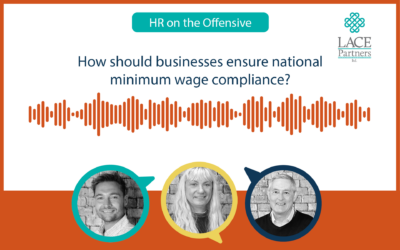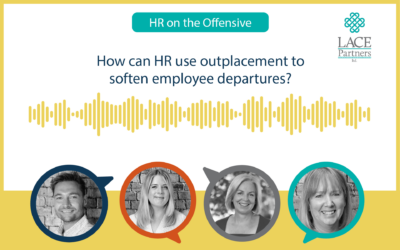Today’s blog comes from our Payroll expert Chris Kirby, who heads up our payroll consultancy services at LACE. As a business we speak to a variety of organisations about how they can improve their payroll function or solve payroll challenges. This includes managing challenging supplier relationships, technology not delivering what is expected of it and more. Today’s blog (which is the first of a two-part piece given the variety of topics!) looks at what opportunities exist for the future of the payroll function.
Whether you’ve seen it or not (it’s not in the Financial Times after all) there is a lot of commentary at the moment around the future of payroll. Perhaps not the most glamorous subject for speculation, but for a department that has traditionally been a back-end, transactional, often never seen ‘as long as your pay is accurate and in your account on pay day’ it is a great opportunity for reinvention, stimulation and optimisation.
The shifting perceptions of the Payroll function and the impact of the Cloud
So why are we seeing the focus shift now? What has changed? And why? What does it mean for the future of the function and what opportunities exist?
There are a number of reasons as to why the shifting importance of the Payroll has become so prevalent and we have spoken to payroll professionals about the current climate being a perfect storm if you are a payroll person wanting to increase exposure of the department and our function as a whole..
It would be very easy to focus on the COVID-19 pandemic here and I will come to that, but firstly I think we need to take a step back to pre-pandemic days, recognising where the broader HR landscape was sitting and more importantly now heading. The decade prior could easily be defined as the ‘Cloud’ era. I don’t think I’m being unreasonable when I say that any organisation that hadn’t moved to, or tried to move to the Cloud in that time, had at least considered it. We’ve seen it across many organisations we have worked with in recent years and have often been called upon to help organisations with their ‘journey to the Cloud’, as they try to improve the efficiency of their operations and digitise their workforces.
I’ve been involved in many ’journey to the Cloud’ projects, as it is so affectionately labelled, but why? The theory behind these Cloud based platforms being the future of HR technology is simple and not really dissimilar to other functions and industries doing the same; reduce costly hosting and maintenance responsibility from your business, simplify the processes and data you have held, moved, added to, manipulated or broken over years of updates, policy changes, and differing requirements you were able to meet when you had control and perhaps most importantly (at least promoted most), provide a modern user experience for your employees who can access via shiny SSO interfaces, apps, and remotely from home as part of the standard package. There are additional benefits of course (continued availability of your systems rather than upgrade outages) and in theory additional security to name a couple more.
Cynically I could summarise that you restrict flexibility, lose an element of control over data, complexity and restrict your ability to offer anything you want to employees. This is all in the name of reducing operating and hosting/maintenance costs and in theory increasing security. That would be very cynical of course, and the reality is, it is right to try and achieve the technical and operational model that an effective move to the Cloud would deliver. This “journey” though is far more than the system as you need to address the wider complexity. You cannot simply shift to a Cloud platform, you need to consider policy harmonisation, data cleansing, or addressing grandfathered agreements which all add multiple flavours to almost everything payroll do. A huge topic and one that I recently wrote a blog on here.
Unfortunately, how this has played out in many organisations is that focus was given solely to the technology implementation and covered only the direct impacts of having the new tool. Many of the critical success factors I have referred to above were either not considered in aggressive, time led implementations, or recognised mid-way through the implementation, blowing the business case in technology siloed projects. This is perhaps the version I’ve encountered most – marked as green on the issue log and labelled “workaround available” only for that workaround to be operationalised and become part of standard process.
Payroll in many organisations had become the brain that had to replace the thinking previously performed by ‘on premise’ bespoke technology solutions. This includes governance and checking processes becoming triggers to perform actions rather than just ensuring everything was in order. As a result, the benefits of the original business case were either not realised or were at least diluted with payroll needing to retain and even increase resources.
The impact of the pandemic
So now to the pandemic. Entering the last couple of years on the foundation I have outlined above meant the Payroll function was always going to be playing a pivotal role in organisations navigating the pandemic. There was additional burden on Payroll teams to support emergency government payment and submission protocols and to handle the ever-changing landscape of requirements from not only those governments, but their organisations who were on the back foot and needed mountains of data to support them in their decision making, all while retaining the focus on paying people accurately and on time. Suddenly everyone was interested in the Payroll function.
At LACE Partners we have heard from not only many of our clients, but from the payroll providers we maintain constant contact with, about this additional focus on data and on the tools they can provide to support businesses with decision making. Time and attendance (T&A) is the perennial hot potato between HR, Payroll, and business hubs. It’s being cemented as a payroll tool both in organisations who expect their Payroll teams to own and govern the data, as well as by providers who are focusing on their T&A offering. Some providers are even looking to build their own integrated tools to move away from previous partnerships with specialist providers.
In addition to this, reporting requirements are changing with businesses wanting to rely on their payroll system to provide an accurate snapshot of costing data, forecasting, and for a picture of where their workforce is or has been. Perhaps it is a result of the decade of streamlining and simplification upstream that businesses quickly recognised the only place they could have all of this data, and more importantly that it would be accurate, was in the Payroll function. Well, that or receive 30 reports they need to join, most of which contained data that is normally fixed in payroll before it is used.
This exposure and shift in expectations has led to the latest payroll buzzword; ‘strategic’. Often used out of context; having a strategy to resolve something isn’t ’strategic‘, in this context the term relates to supporting organisations in decision making or in supporting the initiatives that will help them achieve their group-wide goals, something I think it is fair to say Payroll haven’t traditionally been leant on heavily to do. Another phrase being thrown around is ‘seat at the table’. It is the same thing but is a more optical way of highlighting how important the role of payroll in the new world should be for organisations.
The other significant change that would also support payroll becoming more ‘strategic’ (last time I use the word I promise) is a focus on financial wellbeing. I like this drive and believe Payroll does have a role to play here but I think it also points to a broader shift; people are looking at payroll and seeing what they can offer them rather than just expecting their pay to turn up in their account at the end of the month. I think this will be a significant area of focus and growth for Payroll as an industry in the coming years.
The impact of financial wellbeing
Financial wellbeing and payroll. There are a few angles being explored here and I think they are perfect examples of the balance the Payroll function will need to find as we move into the new world.
One initiative is ‘pay on demand’ and I think this is the perfect illustration of traditional vs modern payroll. In the modern world where almost everything is challenged, it is fair that people are asking why they can’t be paid now for what they have already worked. We aren’t in 1965 anymore; there isn’t the restriction of having to draw cash and fill envelopes, there isn’t even the restriction of three days for a payment to credit.
I am not sure whether the alternative view is more traditional, more cautious, or simply fair but for those of us who count our payroll experience in decades rather than years we have it engrained in us that part of our responsibility to our employees is a social one. It is the reason we may trigger a conversation with someone if we see court order after court order arrive. If they are phoning asking for advances every week, or they are audibly frustrated or angry when engaging with us. Therefore offering money at any time to our employees sits uncomfortably in a world where most of our bills remain cyclical: mortgages, utilities, and other direct debits still come out once a month and often timed just after pay day. Being frank, if at the age of 18 I had the option of having the money I’d earned credited to my account at any point I would probably have entered some financial difficulty. It’s a fascinating balance between what is possible and what is sensible, and also between the traditional vs modern way of life.
I see more mileage in financial wellbeing though. We have seen a well overdue and huge increase in focus on mental wellbeing in businesses, and it is now often seen as a standard part of the benefit and employee support package. It will be a battle between the age old “we can’t give you financial advice” and supporting the modern workforce, but I think there is going to be a place for Payroll supporting employees whether via education or more directly through products or partnerships with people who can give financial advice. The concept of having a financial coach is something so many employees around the world could benefit from in a world where this isn’t something commonly taught in schools, it is in some countries, but fair to say not in the majority. It feels like we are still at the beginning of financial wellbeing becoming normal and it will be fascinating to see where it will go.
On Monday next week we’ll release the second part of this blog series, which will focus on external factors that are dominating the discussions around the future of the payroll function. If you’d like to talk to us about your Payroll function and want some support, you can reach out to us using the form below.









